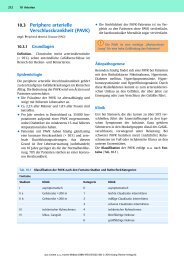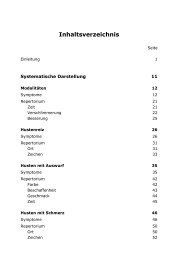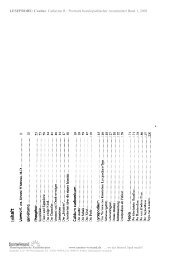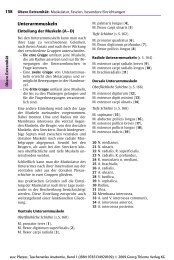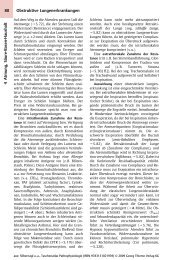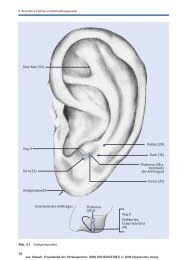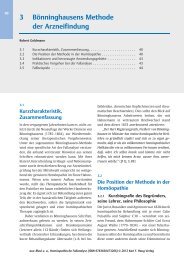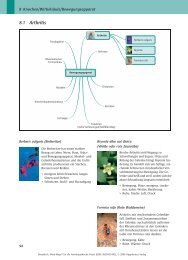alphabetical index of plant families and groups - Sunrise Versand
alphabetical index of plant families and groups - Sunrise Versand
alphabetical index of plant families and groups - Sunrise Versand
Create successful ePaper yourself
Turn your PDF publications into a flip-book with our unique Google optimized e-Paper software.
eports, out <strong>of</strong> over 200 million doses <strong>of</strong> CVT-E002 sold. Reactions included<br />
abdominal pain, confusion, diuresis, dizziness, drowsiness, headache, insomnia,<br />
joint pain, lowered blood pressure, nausea <strong>and</strong> vomiting.’ [www.drugs.com]<br />
Chinese or American?<br />
Allen states that the American <strong>and</strong> Chinese species <strong>of</strong> ginseng are ‘probably<br />
identical’. They are not, although they are in the same genus. Chemically they<br />
are quite similar, both containing ginsenosides as the major biologically active<br />
constituents. Steven Foster, an authority on Chinese medicine, asserts that<br />
‘American <strong>and</strong> Asian ginsengs contain some <strong>of</strong> the same as well as some different<br />
ginsenosides, which explains their different actions as expressed in<br />
traditional Chinese medicine. Mild American ginseng helps to reduce the heat<br />
<strong>of</strong> the respiratory <strong>and</strong> digestive systems, whereas the stronger Asian ginseng is a<br />
heat-raising tonic for the blood <strong>and</strong> circulatory systems.’ American ginseng is<br />
Panax quinquefolius L. <strong>and</strong> Chinese ginseng is Panax ginseng C.A. Meyer.<br />
‘The naturalist Sheng Neng Pen-T’sao introduced around 100 AD an interesting<br />
technique to test the authenticity <strong>of</strong> the ginseng root: “In order to test for<br />
the true ginseng, two persons walk together, one with a piece <strong>of</strong> ginseng root in<br />
his mouth <strong>and</strong> the other with his mouth empty. If at the end <strong>of</strong> three to five li<br />
[about a mile <strong>and</strong> a quarter] the one with ginseng in his mouth does not feel<br />
himself tired, while the other is out <strong>of</strong> breath, the ginseng is genuine root.”<br />
Eastern herbalism met Western culture in 1709 AD when Father Petrus Jartoux<br />
[1668–1720], a Jesuit missionary, visited Northern China. He published a Western<br />
documentation <strong>of</strong> Panax ginseng in 1713. He noted that ginseng could possibly<br />
grow in the mountains <strong>and</strong> woods <strong>of</strong> Canada, since they mimic the environment<br />
<strong>of</strong> the Chinese ginseng.<br />
‘This observation describes the North American ginseng <strong>and</strong> would later be discovered<br />
as the “cooling” ginseng, or the yin ginseng, completing the “warming”<br />
yang ginseng, native to China. Ginseng was an important part <strong>of</strong> Native<br />
American culture. Although there is no formal documentation <strong>of</strong> ginseng usage<br />
in Native American herbal remedies, there is evidence <strong>of</strong> its influence in the<br />
Northeast Culture Area tribes. These inhabitants covered the Atlantic coastal area,<br />
across the Appalachians to the Mississippi, from the Great Lakes to the Cumberl<strong>and</strong><br />
River in Tennessee. The tribes <strong>of</strong> this area were not only hunters <strong>and</strong> fishermen,<br />
but also farmers <strong>and</strong> herb-gatherers. They utilised herbs for ritualistic<br />
ceremonies <strong>and</strong> for practical purposes, such as prevention <strong>and</strong> cure <strong>of</strong> illnesses,<br />
wound dressing, treatment <strong>of</strong> female ailments, increase elderly strength, promote<br />
fertility, enhance mental activity, stomach upset <strong>and</strong> the treatment <strong>of</strong> ear <strong>and</strong><br />
eye disorders.’ [Gehr 2000]<br />
In 1715 Joseph Francois Lafitau [1681–1746], another Jesuit missionary who<br />
worked above Montreal in Canada from 1711–1717, read Jartoux’s words, then<br />
began a search for ginseng in Canada. In 1716 Lafitau, strolling in the woods<br />
near his cabin, found the red-berried <strong>plant</strong>. American ginseng [Panax quinquefolius]<br />
was discovered.<br />
According to traditional Chinese medicine, American ginseng is a Yin tonic<br />
<strong>and</strong> cool in nature. Asian ginseng, by contrast, is a Yang tonic <strong>and</strong> generally warm<br />
© Saltire Books Ltd<br />
Family ARALIACEAE 501



